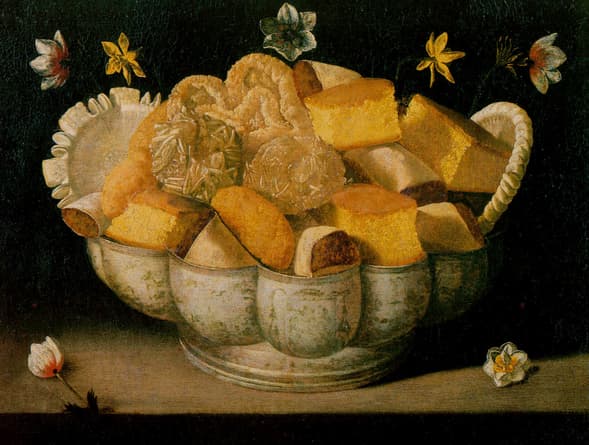Meet the Baroque-Era Painter Who Extolled the Creative Power of Women
Josefa de Obidos was the most brilliant still life painter of the Baroque era you’ve probably never heard of.

The arrival of spring and the vernal holidays is an apt moment to reintroduce Josefa de Óbidos, the most brilliant still life painter of the Baroque era you’ve probably never heard of — despite having had a successful career as a female artist in 17th century Portugal, an unprecedented achievement.
Her painting “Still Life with Cakes,” a visually delicious picture of Portuguese confections piled high in a lobed porcelain bowl, is thought to be a celebration of the end of Lent. The understated masterpiece shows de Óbidos at her best while touching on aspects of her unusual life story.
Josefa de Óbidos (née Josefa de Ayala e Cabrera) was born in 1630 in Seville, then the cultural capital of Golden Age Spain.
In Portugal, then under Spanish rule, she created her first known artworks as a teenager boarding at a convent. De Óbidos’s father, by then a successful court painter in Portugal, supported her early development, purchasing art materials for her.
Despite the limited options then available to women, de Óbidos chose not to marry or take vows at the convent. With permission from her parents, she was legally emancipated, obtaining the right to operate her own business, a status otherwise unheard of at the time.
She set up shop at Óbidos, her father’s hometown, a medieval walled city, where she ran a studio, earning her living as a painter and landowner.
She would work both alongside her father and independently, signing her pictures “Josepha em Óbidos,” or Josefa in Óbidos, earning her moniker.
Together, she and her father brought the Spanish bodegón still life genre — depictions of fruits, vegetables, and pantry items, sometimes featuring figures in kitchen scenes — to Portugal, where they created tenebrist paintings of local produce and game.
Although de Óbidos is assumed to have trained with her father, her pictures have more dynamic compositions and crisp, clear color. Recent research comparing their techniques suggests that she was the more technically advanced artist, outstripping her father early on.
Part of the permanent collection of the Évora Museum in Portugal’s Alentejo region, “Still life with Cakes” is displayed near other paintings by Josefa de Óbidos and works by her father, giving visitors an opportunity to compare stylistic differences between them.
“Still Life with Cakes” may have been a commission. The fine porcelain bowl was likely an expensive import from China. Portugal lacked the technology to create such delicate earthenware at the time.
A faint coat of arms and cardinal’s hat can be discerned on the bowl, suggesting the dish may have been created for a specific patron, maybe a Portuguese church official from an aristocratic family, perhaps someone with a sweet tooth.
Yet this is also a painting by a woman extolling the creative power of women. In those days, convents used egg whites to iron and stiffen clerical garments and leftover yolks were used by nuns to create tasty treats.
Baking pão-de-ló, a Portuguese sponge cake, mince pies, and almond cookies, treats you can still find in pastellerias across Portugal, was an activity de Óbidos may well have witnessed firsthand during her stint at the nunnery. Here, the textures of the various baked goods, lovingly rendered, demonstrate her virtuosity with the brush.
Sweet treats like these were commonly enjoyed around Eastertide. Paired with spring flowers, experts suggest this still life may have been conceived as a vernal picture celebrating the end of Lent. The tulip and daffodil stems behind the bowl are barely visible against the Spanish-style black background, blossoms appearing to float above the sweets at first glance.
Josefa created spatial tension by depicting the flowers in the foreground, one on either side of the porcelain bowl, a bit smaller than the flowers in the background, subverting the principle that objects diminish in size as they recede in space. The flowers surrounding the still life create a rectangle within a rectangle, framing the strange, scalloped forms.
De Óbidos’s unlikely career, a blip in the art history books, is a testament to her talent and drive, as well as her unusual upbringing. While she also painted biblical scenes with figures, those pictures lack the naturalism of her still lifes.
The people populating her religious artworks appear caricatured, with oversize heads, red cheeks, and cartoonishly large, tear-filled eyes. Perhaps she painted from still life directly but, because she was a woman, did not have access to live models.
Whatever the reason for the discrepancy, de Óbidos’s “Still Life with Cakes” is on par with the greatest bodegones of her day, a triumphant canvas inviting viewers to delight in nature’s bounty and the sweetness of springtime.
